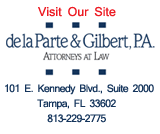|
Spring 2012
IN THIS ISSUE
d&G Lawyer News
|

Green Building: Be both Environmentally and Legally Conscious
By: Patrick McNamara and Eric D. Nowak
In a world of high energy prices and climate change, green building issues are becoming more common in the construction and real estate market. As green building becomes more prevalent it is important to remember that there are legal considerations that should not be lost in the rush to change building practices. Both clients and attorneys should become familiar with the benefits and risks involved with green building.
There are large energy and cost savings to be gained from changing building practices to make buildings more efficient. As of 2009, buildings represented 72% of U.S. consumption; 38.9% of energy use (including fuel input for production); and 38% of all carbon dioxide emissions.1 According to the United States Green Building Council (“USGBC”), green buildings utilize less energy and fewer resources in comparison to conventional buildings; on average, 26 percent less energy; 13 percent lower maintenance costs; 27 percent higher occupant satisfaction; and 33 percent less greenhouse gas emissions than conventional buildings. 2 According to the Green Building SmartMarket Report in 2006 by McGraw-Hill Construction, green buildings average a 6.6% improvement on the return on investment, 8-9% decrease in operating costs of the building, 7.5% increase in the building’s value, and a 3.5% increase in occupancy ratio. 3 There are also governmental incentives in the form of tax credits and rebates that can also help defray the initial cost of investing in green building. 4
However, there are also risks and potential liabilities that should be considered and addressed prior to beginning a green construction project. The risks of green building include, but, are not limited to:
(1) Buildings failing to achieve the desired building certification (such as LEED, Leadership in Energy and Environmental Design Green Building Rating System);
(2) Buildings failing to qualify for tax credits;
(3) Rising costs associated with delays from a builders’ failure to meet standards set up by certification organizations;
(4) Design professionals’ heightened liability from design defects that lead to:
(a) An owner’s failure to obtain certifications, such as LEED;
(b) The failure of a system or component of a green building to perform adequately over the structure’s lifetime;
(c) Insurance exclusions where the designers warrant certain outcomes;
(5) Increased liability for contractors and sub-contractors when their contracts require that construction meets certain green standards which may trigger warranty exclusions in their insurance policies;
(6) Tenants of green buildings failing to realize adequate cost savings from green buildings and landlords failing to live up to claims in their marketing or promotional materials; and
(7) Unexpected and unintended consequences resulting from the use of green materials, such as increased risks of mold and moisture intrusion from green building techniques, such as vegetative roofs, the use of recycled materials, and increased ventilation of outdoor humid air. 5
These risks, if not properly addressed at the outset, could lead to litigation involving claims for breach of contract, negligence, and statutory causes of action, among others.1 Design professionals, contractors, and sub-contractors’ contracts should be drafted to properly allocate these risks and insurance should be procured to cover the particularized risks associated with green building.7 Construction schedules should be negotiated and delays for green building permitting, limited availability of construction materials, and delays for green certification should all be built into these schedules. 8 Contractors should be careful to ensure their contract allows for a broad right to extensions to protect from the attenuated risks involved in green construction.9 Owners should make clear and specific the certification they are trying to achieve, their time constraints, and the longevity they are seeking to achieve from their investment. Owners should also review their insurance policies to determine whether the policy will cover any potential consequences from green construction, such as moisture intrusion and mold.10 Above all, clients and attorneys should communicate with each other to quickly identify new and developing risks as green building becomes more prevalent.
Green building presents a business a great opportunity to save money and help minimize its carbon footprint. However, these benefits are not without risks. As a result, it is important for attorneys and their clients to appropriately manage the particularized risks involved with green building and address them up front and comprehensively.
1 U.S. Green Building Council, Green Building Facts, April 2009, http://www.usgbc.org/ShowFile.aspx?DocumentID=3340.
92 U.S. Green Building Council, Green Building, USGBC and LEED, February 2010, https://www.usgbc.org/ShowFile.aspx?DocumentID=1991.
3 McGraw-Hill Construction, Key Trends in the European and U.S. Construction Marketplace SmartMarket Trends Report, 2008.
4 The Florida Green Building Coalition has a comprehensive list of these incentives, http://floridagreenbuilding.org/incentives.
5 See Kate Bowers et al., The Green Building Revolution: Addressing and Managing Legal Risks and Liabilities Harv.J.L. & Tech. 6-7 (2009) (http://www.mgkflaw.com/Green%20Building%20Revolution.pdf); see also, J. David Odom et al., Guest Article: The Hidden Risks of Green Buildings: Why Building problems are Likely in Hot, Humid Climates, Environmental Observer, August 26, 2009, http://newsletters.agc.org/environment/2009 /08/26/guest-article-the-hidden-risks-of-green-buildings-why-building-problems-are-likely-in-hot-humid-climates.
6 See Bowers, supra note 5, at
7Some good strategies to address these risks can be found in: Michael P. Sams, Identifying and Managing Green Building Risks, FOR THE DEFENSE, June 2010 at 49.
Id. at 51-52.
Id.
10See Odom, et. al, supra note 5.
|


